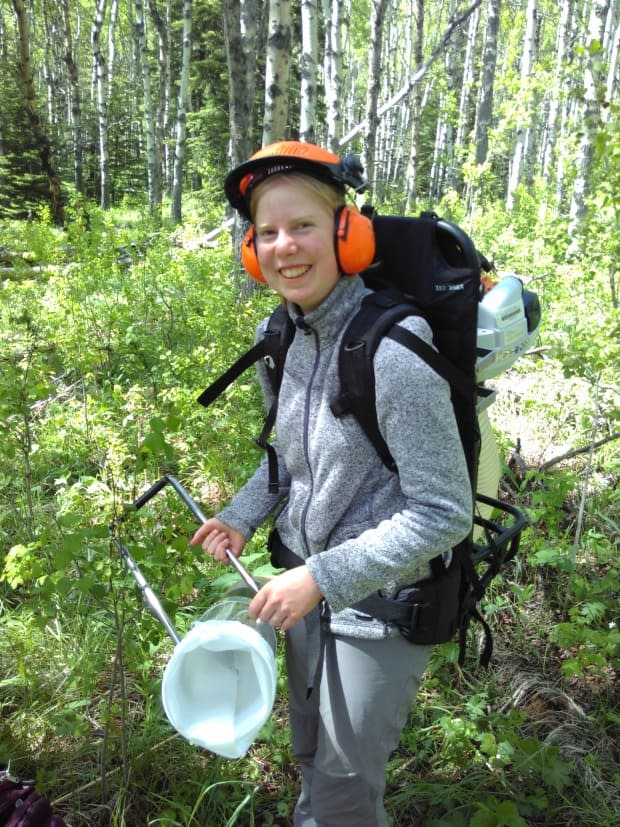Invasive earthworms are spreading through Canadian forests, and that's bad for bugs

In many parts of northern North America, there have been no earthworms since before the last ice age. Now, with help from humans, invasive earthworms are colonizing new areas. And in areas of a forest with more invasive earthworms, there are fewer insects, a new study has found.
The study authors say that along with climate change, land use change and pesticides, earthworm invasions might be an "underappreciated driver" in a widespread decline of insects that some scientists have raised the alarm about.
Invasive earthworms have already been linked to changes in soil organisms, plant communities and forests' ability to store carbon.
So Malte Jochum, who led the new study in an aspen forest west of Calgary, expected worms might have some impact on insects. Still, he was "awestruck" by the size of the impact, said Jochum, a biologist and ecologist at the German Centre for Integrative Biodiversity Research and the University of Leipzig.

In areas with the highest mass of earthworms, there were on average 61 per cent fewer individual insects, 18 per cent fewer species and a 27 per cent reduction in the total mass of insects, the researchers reported this week in the journal Biology Letters.
While competition for food and habitat clearly played a role for some organisms, the ripple effects could be seen through the food web, even among organisms with no known direct predator-prey or competitive relationship to earthworms.
"It's fascinating how below-ground invasions can have such an impact on above-ground animals," Jochum said.
Earthworm invasions are widespread on the continent, and increasing in the north as permafrost thaws.
"The scale of it is huge and will probably expand with climate change," Jochum said. He noted that there's no reason to think other ecosystems being invaded by earthworms would respond differently. And he thinks it's something people should be mindful of as they garden or fish, potentially transporting worms to new places.
"It seems that people living in North America don't know that earthworms don't belong there … and I think it's always important to remind people of that."
How the earthworm invasion began
During the last ice age, most of North America was covered by a massive ice sheet. When the glaciers retreated, organisms such as insects and plants started to recolonize, explains Ed Johnson, a University of Calgary professor emeritus who co-authored the study.
"The system has reorganized itself without [earthworms]," he said. "And when they show up, the system gets reorganized again."

Researchers first noticed earthworms invading the aspen forest surrounding the University of Calgary field station in the 1980s, Johnson said. He suspects they've been in the area — the Kananaskis Valley in the front ranges of the Rocky Mountains alongside Barrier Lake — since the 1960s. The worms, many of them invasive species not native to North America, first show up near cabins, fishing spots or places horses have been — a sign they've been brought by humans.
Over decades, generations of researchers have watched and tracked the invasion. "Sometimes you can literally see it" in the changes to the leaf litter, Johnson said.
The 'Ghostbusters machine' and how the study was done
When Jochum joined the project, he came with some experience studying small creatures such as insects and an interest in seeing what earthworms' impacts might be above the ground.
The researchers decided to look at square plots within the forest of slender trees such as aspen and poplar, many with signs of having been scratched by bears. They sucked small creatures ranging from leafhoppers to spiders from the dense undergrowth littered with dead wood, using a vacuum carried like a backpack. Jochum describes it as looking like the "Ghostbusters machine."

They also counted earthworms in the soil underneath for comparison, drawing them out with an irritating mustard solution.
Where there were more worms, there were markedly fewer insects in number, species and mass. "I was surprised by the strength and severity," Jochum said.
As expected, insects that compete with earthworms for rotting organic matter were negatively impacted. But there were a few winners — predators such as spiders and parasitoids. Why they increased in numbers as earthworms invaded is still a mystery to be solved.
The study was funded by the European Research Council and the German Research Foundation.
What this means for people who fish and walk in the woods
Carol Frost, an assistant professor and insect and spider ecologist at the University of Alberta, said the study looks at a "super-interesting question." But she knows from her own research on impacts of invasive species that this kind of study is quite difficult because so many variables can impact the results, from elevation to the types of vegetation on a given plot. She'd like to see the study repeated in other places with earthworm invasions.
Joann Whalen, a professor and soil scientist at McGill University who has surveyed earthworms in southern Quebec and found many of the same species, said she was intrigued by the study's findings.
"I think there are some lessons to be learned from this study," she said. "If we don't pay attention and let earthworms get into new habitats, they're going to cause some changes that are quite dramatic and very unexpected effects."

She said many people think of earthworms as beneficial, but this shows another side, and suggested it might be worth raising some public awareness.
Dezene Huber, a professor of ecosystem science and management at the University of Northern British Columbia who studies the impact of disturbances such as wildfires and climate change on insect and spider biodiversity, agreed.
"I think it should really drive home … the fact that we need to really work at trying to keep earthworms out of those areas where they haven't invaded already."


